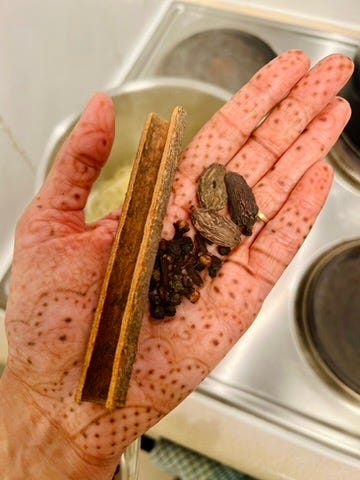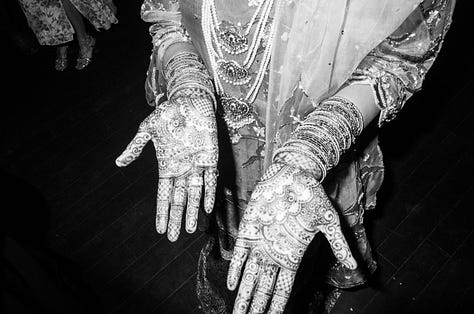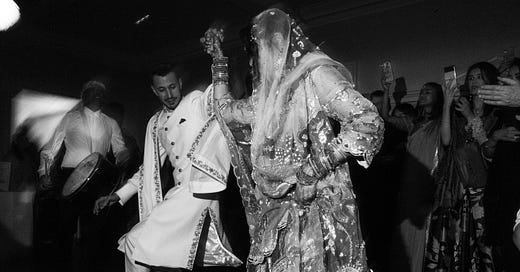Autumn: The Perfect Bite
on first bites and my recipe for Khichdi, Mujaddara style; hands off Lebanon
I haven’t cooked a single thing all September and it’s been the best feeling.
Let me explain.
First, some excuses about being out of the kitchen – I moved home on 1st September, into a building site, where I was without a working kitchen. I had no choice but to order in food or escape the domestic mayhem by eating at local eateries.
Once the literal dust settled, after the builders had moved out, I was caught in the whirlwind of a desi wedding of my own making! Between the wedding dawat and entertaining out of town guests and in-laws, I found myself being wined and dined for a whole month.
Not cooking at all, at all, (ever!) is normal for some but for a woman who’s made a living in the kitchen, it’s very strange. And yet, it felt kinda good. You see, work has felt more and more like work lately. Non-stop catering events have been exhausting over the years and the ability to shake it off has become harder. The need to focus on my personal life came at the right time, giving me space to reflect and to regroup.
I’m writing this newsletter on 1st October and it feels like autumn, the changing season shedding off old leaves on the trees outside while I’m creating something new here.
I was back in the kitchen yesterday, making dinner and a dish for this newsletter, the two wrapped into one. It’s nothing fancy, I’d say, yet this simple act of cooking has given me a sense of satisfaction I hadn’t felt in a long time.
There was the effortless joy of standing over the sizzling onions, scooping them out of the hot oil as they caught colour, caramelising. I watched over them with affection, as they curled up like a sleeping baby, as they laid on the blue parchment, cooling down and gently settling into a tawny glow. I sprinkled sea salt over them to lock in some crispiness, smiling to myself for a job well done.
I reached for one of the glistening crisps, put it inside my mouth and tasted it. My onions are perfect.
October: The First Bite
Nothing beats a ‘first time’. Baby’s first sugar, first day at school, first period, first everythings. Firsts are important. They set the tone for the experiences that follow.
However, it’s not as simple as that. The first bite is not a straight line experience.
To start, the first bite – the initial experience before a good meal – begins by awakening each one of our senses, then the actual physical bite follows. We can smell the food as it arrives, hear the sizzle from a distance; we often decide if we’ll enjoy a meal as we see it, as it is plated in front of us. To taste what we eat, we must be receptive – the feel of the breaking roti against our fingers, scooping the gravy, the daal, the fibres of tender meat, preparing a morsel, all establish how the food will eventually taste to us.
Secondly, I believe that it isn’t the first bite, but the second one that establishes a relationship with our food.
The only wisdom I took away from a whiskey tasting back in my twenties was the significance of the second sip. Number one, you coat your mouth with the whiskey to acclimatise to the alcohol: take a small sip, swivel it in your mouth and spit it out. Now take the second sip, larger than the last, and let it sit in your mouth against your tongue. This is where the whiskey’s flavour profile will reveal itself to your taste buds – notes of vanilla, tobacco, oak, as you like.
Similarly, the first bite of a good meal is one to satiate the excitement of the meal to follow. It is only as you continue to eat, that the flavour profile develops. The gentle heat of chilli powder cooked into the masala will slowly creep up on you, building in the base of your throat with every bite, teasing you to take another bite.
And when it starts to feel like too much, and you have had enough, it is time to stop my friend. Or, at least, to pause for water.
Talking about the first bite, is also talking about the second bite, and every bite that follows. And, perhaps, every bite is a first because every morsel adds something new to the eating experience.
Like a good millennial brown girl pandering to the mainstream media narrative, I love talking about how my grandmother taught me how to cook. But I don’t remember the first time I was taught how to cook.
You could only learn from watching my Nani Jaan in the kitchen, who is famous for giving daily stovetop demonstrations of roti making from scratch. Over the years, my memories of her countless, perfect unleavened flat breads have blurred into the one cooking lesson I had received as a child, but I never knew I was receiving.
Nani Jaan poured atta flour and water, nothing else, which she measured by eye, into a bowl and gently brought it together by moving her fingers back and forth, up to her wrists. She punched with both knuckles until she formed a smooth dough, with the slightest bounce back when you poked it, and she covered it with a damp cloth. She put it aside in a cool place. Only Nani Jaan knew when the dough had rested enough and, without checking, she proceeded with making the rotis. Nani Jaan squeezed dough balls between her clenched fists, a technique best understood in seeing it with your own eyes. The balls were smoothed and spun in her palm, then she laid them out neatly on the countertop, in front of a rolling pin, which she had dusted with flour. She heated the tawa on high flame, turning on a second burner beside it. And, with immediacy, the dough balls squeezed, pinched and rolled out. Suddenly, they were on the tawa and we watched in awe. The rotis were spun with the chimtta once the dough colour had changed, flipped, spun and flipped again. And, before we knew it, Nani Jaan had flung the roti onto the open flame, igniting burnt pockmarks, the roti inflating as if by magic because Nani Jaan was a magician of our own.
The first roti happened so fast, you barely noticed Nani Jaan had already rolled out the second roti.
This month’s recipe: Khichdi, Mujaddara style
There are many versions of Khichdi out there. Rice and lentils are eaten together across many cultures. Science says they are both incomplete proteins and, when eaten together, they become whole and form a full protein.
(Days after getting married, I’m finding everything romantic including the happy union of rice and lentils <3)
Khichdi is the dish my mother makes when you’re feeling poorly. It comforts; it says that you’re in safe hands.
If I’m to share Pakistani recipes, I reckon Khichdi is a good place to start. The ingredients are classic to the cuisine and a gentle entry point. The technique remains simple, the onions are the only element that needs a bit of attention.
I also chose this recipe because every time I cook it, my (now) husband tells me about his favourite dish from home – Mujaddara. He tells me he loves cooking this dish when he misses home, Lebanon.
I started talking about making Khichdi and its similarities to Mujaddara while I was sitting at the table with both my and my husband’s families. Here is how it went:
My father in law advised me to take the onions out of the hot oil just as they begin to brown. To use the same oil to temper the spices and to cook the rice and the lentils. This will give the dish flavour and its distinct earthy colour, as he described it. While my mum jumped in to tell me that I should spread the onions on kitchen paper to allow them to crisp.
‘I’ve found that sprinkling salt on the onions as soon as they come out of the oil will keep the onions crispy,’ my aunt interjected.
I said that I’d cook the rice and lentils in stock. I was met with silence.
‘Then it will be like a pulao not khichdi,’ my mum pondered.
‘This is not the Lebanese way.’ My father in law advised me with a full stop.
There, it was time to end our conversation about Arab and desi cooking traditions. For now, at the least.
Two days after my wedding, when we danced to Punjabi dhols and Lebanese zafa hand drums, Israel began to bombard southern Lebanon aggressively. My husband’s paternal aunts spent the next 24 hours trapped in their cars, on the highway, in an attempt to flee the incessant bombing. Since then, we sit anxiously watching the news and waiting for messages and calls from family and friends. As I’m writing this, Israel is still bombarding Lebanon and has started a ground offensive in the Southern regions. And we continue to wait for notifications to pop on our phones, so we can hear if our family is safe.
So, I thought of Lebanon as I cooked my version of Khichdi for my husband and I the other day. I took some of the lessons I learnt about making Mujaddara and, much like our blended wedding, I brought a bit of both of us to the dish.
Khichdi is best served on a windy and wet day, when you’ve spent the week eating heavy wedding dawat food and your belly needs something simple to digest. Cook it when someone you love is hurting and no words can soothe them. Eat it when you miss home – when home is in pain and you are too far to comfort it – so all you can do is comfort yourself.
Hands off Lebanon.



Ingredients:
1 cup of long grain rice
1 cup of whole grain moong daal (Mujaddara calls for 2 cups of daal, your call but don’t tell my father in law)
1 large white onion
⅓ cup of olive oil
2 crushed garlic cloves
1 inch of crushed ginger
3 black cardamoms
1 tsp of black cloves
1 tsp of whole black pepper
4 inches of dal chini
2 tsps of ground cumin
1 tsp of ground allspice
2 tsps of salt
1 vegetable stock cube
Method:
Soak the rice and lentils in water. Set aside.
Slice the onion thinly and throw them in a pan with a gulp of olive oil. Heat over a medium flame. Let the heat rise until the onions start sizzling, stirring occasionally to prevent the onions on the edges of the pan from burning. Keep an eye on the onions and try to remove any bits that begin to burn. (The rancid burnt bits will ruin the flavour of the overall dish.)
Just as the onions start to brown, scoop them out of the oil. I find this step easier if I pour the oil and onions over a bowl and large sieve. Sprinkle sea salt over the onions and spread them out on parchment paper to allow them to crispen.
(An explanatory note before we move on to the next step: the classic Pakistani Khichdi recipe doesn’t call for removing the onions, so you’d keep cooking them until they’d be caramelised, mixing in the rice and the lentils. The beauty of Mujaddara, however, lies in the crispy onions. I’m a sucker for texture and sweetness and so this is what I blend into my version.)
Pour the hot oil back into the pan. Add the whole spices, then the garlic and the ginger. Give it a minute, or until you can’t smell the raw garlic anymore. Add the ground spices, stock cube and salt. Pause, then add the drained rice and lentils. Add 2.5 cups of water and bring it to a boil. Stir. Once the water bubbles vigorously, lower the heat to a low simmer and cover the pan with a lid.
Simmer on a low heat for 10 minutes. Then turn the heat off and let the mixture cook in its own steam for another 10 minutes. Take the lid off and stir. Sprinkle half of the crispy, caramelised onions into the Khichdi. Serve, topping the plates with the remaining crispy onions as you do.
Eat Khichdi with yoghurt and tahini sauce.
Numra x
If you enjoy this newsletter, feel free to share it with friends.
PS. head to my website for more recipes and to learn more about my catering and supper clubs.








I felt your heart and soul through these beautifully crafted words. It might even be your best one yet!
Beautifully written! Loved reading this and will absolutely make this khichdi